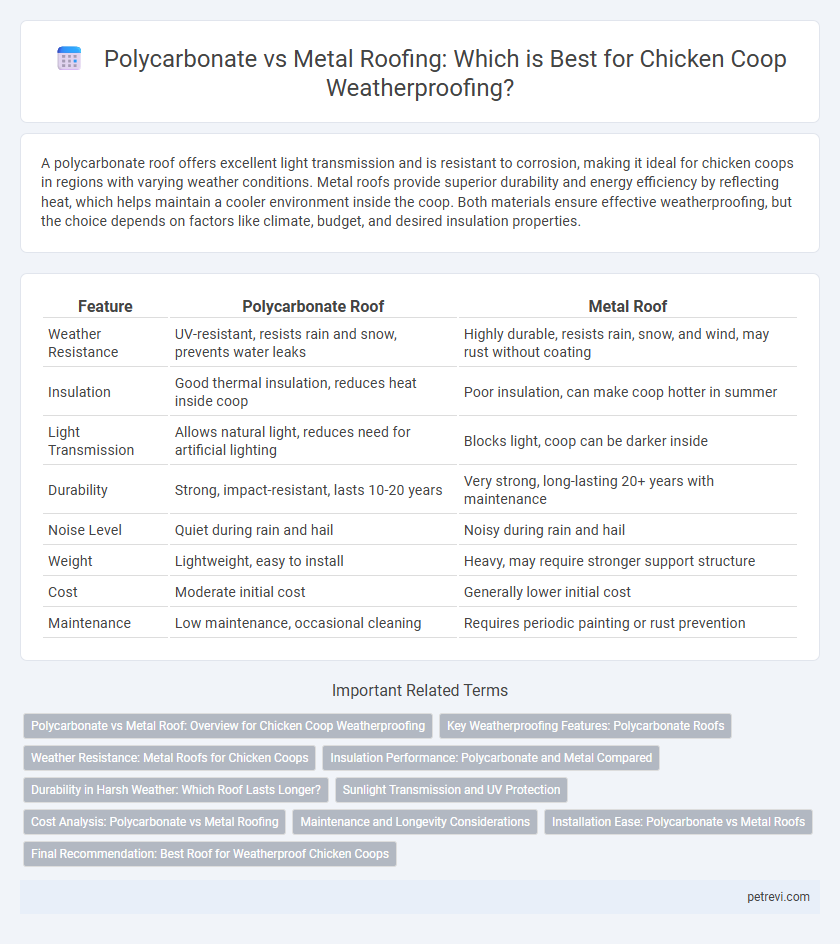A polycarbonate roof offers excellent light transmission and is resistant to corrosion, making it ideal for chicken coops in regions with varying weather conditions. Metal roofs provide superior durability and energy efficiency by reflecting heat, which helps maintain a cooler environment inside the coop. Both materials ensure effective weatherproofing, but the choice depends on factors like climate, budget, and desired insulation properties.
Table of Comparison
| Feature | Polycarbonate Roof | Metal Roof |
|---|---|---|
| Weather Resistance | UV-resistant, resists rain and snow, prevents water leaks | Highly durable, resists rain, snow, and wind, may rust without coating |
| Insulation | Good thermal insulation, reduces heat inside coop | Poor insulation, can make coop hotter in summer |
| Light Transmission | Allows natural light, reduces need for artificial lighting | Blocks light, coop can be darker inside |
| Durability | Strong, impact-resistant, lasts 10-20 years | Very strong, long-lasting 20+ years with maintenance |
| Noise Level | Quiet during rain and hail | Noisy during rain and hail |
| Weight | Lightweight, easy to install | Heavy, may require stronger support structure |
| Cost | Moderate initial cost | Generally lower initial cost |
| Maintenance | Low maintenance, occasional cleaning | Requires periodic painting or rust prevention |
Polycarbonate vs Metal Roof: Overview for Chicken Coop Weatherproofing
Polycarbonate roofs offer superior light transmission and UV protection, which helps maintain a warm and healthy environment in chicken coops. Metal roofs provide durable weather resistance and strong impact protection but can cause excessive heat buildup inside the coop during hot weather. When weatherproofing a chicken coop, polycarbonate roofing balances insulation and ventilation better than metal roofing, reducing stress on chickens from extreme temperature fluctuations.
Key Weatherproofing Features: Polycarbonate Roofs
Polycarbonate roofs offer exceptional weatherproofing for chicken coops due to their high impact resistance and UV protection, ensuring durability under harsh sun and heavy rain conditions. Their translucent nature allows natural light to penetrate, reducing the need for artificial lighting while maintaining a controlled temperature inside the coop. These roofs also provide excellent insulation properties, helping to keep chickens warm during cold weather and cool during hot seasons.
Weather Resistance: Metal Roofs for Chicken Coops
Metal roofs for chicken coops offer superior weather resistance due to their durability and ability to withstand extreme temperatures, heavy rain, snow, and strong winds without corrosion. Their reflective properties help regulate coop temperatures, preventing overheating during summer months and reducing condensation in colder weather. Rust-resistant coatings and galvanized steel options ensure long-term protection against moisture damage, maintaining a dry and secure environment for chickens year-round.
Insulation Performance: Polycarbonate and Metal Compared
Polycarbonate roofs provide superior insulation for chicken coops due to their ability to trap heat and reduce temperature fluctuations, maintaining a more stable environment for poultry. Metal roofs, while durable and weather-resistant, tend to conduct heat and cold rapidly, leading to greater temperature extremes inside the coop. Choosing polycarbonate roofing enhances the energy efficiency of the coop, contributing to improved chicken health and comfort.
Durability in Harsh Weather: Which Roof Lasts Longer?
Polycarbonate roofs offer exceptional durability in harsh weather due to their impact resistance, UV protection, and flexibility, making them less prone to cracking or denting under extreme conditions. Metal roofs, typically made from galvanized steel or aluminum, provide robust structural strength and excellent longevity, but can be susceptible to rust and corrosion without proper coatings. Overall, polycarbonate roofs tend to last longer in environments with frequent hail, heavy rain, or snow, while metal roofs excel in windy and high-temperature climates when maintained properly.
Sunlight Transmission and UV Protection
Polycarbonate roofs offer superior sunlight transmission, allowing natural light to penetrate the chicken coop, which promotes healthier poultry growth by simulating natural daylight conditions. These roofs also provide excellent UV protection, reducing harmful rays that can stress chickens and degrade coop materials over time. Metal roofs, while durable and weather-resistant, typically block more sunlight, potentially requiring additional artificial lighting to maintain optimal chicken health.
Cost Analysis: Polycarbonate vs Metal Roofing
Polycarbonate roofing for chicken coops typically costs between $15 to $30 per square foot, providing lightweight and impact-resistant protection, while metal roofing ranges from $5 to $12 per square foot, offering superior durability and longevity. Installation costs for polycarbonate panels are generally lower due to easier handling and cutting, but metal roofs may require professional installation to manage weight and secure fasteners properly. Considering both material and labor costs, metal roofs tend to have a higher upfront expense but offer better long-term value due to their lifespan and minimal maintenance requirements.
Maintenance and Longevity Considerations
Polycarbonate roofs offer high durability with UV resistance, requiring minimal maintenance and lasting up to 10-15 years when properly cared for. Metal roofs excel in longevity, often exceeding 20 years, and provide superior resistance to extreme weather, though they may require occasional rust prevention treatments and inspections for fastener integrity. Choosing between the two materials depends on balancing ease of upkeep with long-term durability to ensure optimal weatherproofing for chicken coops.
Installation Ease: Polycarbonate vs Metal Roofs
Polycarbonate roofs offer lightweight panels that simplify installation, requiring fewer tools and less structural support compared to metal roofs. Metal roofs, while durable, often demand more precise cutting, heavier framing, and specialized fasteners to ensure weatherproof sealing. For chicken coops, polycarbonate roofs provide a quicker, user-friendly assembly process, especially beneficial for DIY builders prioritizing ease and speed.
Final Recommendation: Best Roof for Weatherproof Chicken Coops
Polycarbonate roofs provide superior light transmission and durability, making them ideal for maximizing natural sunlight in chicken coops while ensuring strong weather resistance against rain and wind. Metal roofs offer excellent longevity and robust protection against extreme weather, but they typically reduce natural light inside the coop, which can affect chicken health and behavior. For weatherproofing chicken coops, polycarbonate roofs are the best choice due to their combination of weather resilience, light permeability, and ease of installation.
Polycarbonate Roof vs Metal Roof for Chicken Coop Weatherproofing Infographic

 petrevi.com
petrevi.com